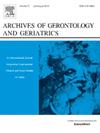Pinch strength as an independent correlate of cognitive impairment beyond grip strength in older adults
IF 3.5
3区 医学
Q2 GERIATRICS & GERONTOLOGY
引用次数: 0
Abstract
Objectives
To compare pinch strength parameters against grip strength metrics for identifying cognitive impairment in community-dwelling older adults.
Design
Cross-sectional analysis of baseline data from a prospective cohort study.
Setting and participants
954 community-dwelling older adults from three communities.
Methods
Pinch and grip strength were measured using portable dynamometers. Derived metrics included peak strength, coefficient of variation (CV), fatigue index, and pinch/grip ratio. Functional assessments were also collected. Cognitive impairment was defined by a Mini-Cog score ≤ 2. Multivariable logistic regression models, adjusted for age, sex, and education, assessed associations between standardized strength metrics and cognitive impairment, reporting adjusted odds ratios (ORs) and 95 % confidence intervals (CIs). Model performance was compared using Area Under the Receiver Operating Characteristic Curve (AUC), Decision Curve Analysis (DCA), and calibration.
Results
Cognitive impairment prevalence was 32.7 % (312/954). Lower peak pinch strength strongly correlated with cognitive impairment (OR 0.50, 95 % CI 0.40–0.61), remaining robust after adjusting for grip strength (OR 0.48, 95 % CI 0.38–0.60). Peak grip strength association attenuated when pinch was included. Higher grip strength CV also correlated with cognitive impairment (OR 1.2–1.3, p < 0.05). A simple model with peak pinch strength (AUC 0.689) performed comparably to a full model (AUC 0.699, p = 0.121) and significantly better than a peak grip strength model (AUC 0.633, p < 0.001). DCA indicated clinical utility for pinch-strength-based models.
Conclusions
Peak pinch strength demonstrated a stronger association with cognitive impairment than peak grip strength. This finding warrants further research into the mechanisms linking fine motor strength and cognition.
握力是老年人握力以外认知障碍的独立相关因素
目的比较捏握力参数与握力指标在识别社区居住老年人认知功能障碍中的作用。设计前瞻性队列研究基线数据的横断面分析。环境和参与者:来自三个社区的954名居住在社区的老年人。方法采用便携式测力仪测定握力和旋紧力。衍生指标包括峰值强度、变异系数(CV)、疲劳指数和捏握比。功能评估也被收集。Mini-Cog评分≤2分定义认知功能障碍。校正了年龄、性别和教育程度的多变量logistic回归模型评估了标准化力量指标与认知障碍之间的关联,报告了校正优势比(ORs)和95%置信区间(ci)。采用受试者工作特征曲线下面积(AUC)、决策曲线分析(DCA)和校准对模型性能进行比较。结果认知功能障碍患病率为32.7%(312/954)。较低的峰值握力与认知障碍密切相关(OR 0.50, 95% CI 0.40-0.61),在调整握力后仍保持稳健(OR 0.48, 95% CI 0.38-0.60)。峰值握力关联减弱时,捏包括在内。握力CV与认知障碍也有相关性(OR 1.2-1.3, p <;0.05)。具有峰值夹紧强度(AUC 0.689)的简单模型的性能与完整模型(AUC 0.699, p = 0.121)相当,且显著优于峰值夹紧强度模型(AUC 0.633, p <;0.001)。DCA显示了基于捏紧强度的模型的临床应用价值。结论言语握力与认知功能障碍的相关性强于峰值握力。这一发现为进一步研究精细运动力量和认知之间的联系机制提供了依据。
本文章由计算机程序翻译,如有差异,请以英文原文为准。
求助全文
约1分钟内获得全文
求助全文
来源期刊
CiteScore
7.30
自引率
5.00%
发文量
198
审稿时长
16 days
期刊介绍:
Archives of Gerontology and Geriatrics provides a medium for the publication of papers from the fields of experimental gerontology and clinical and social geriatrics. The principal aim of the journal is to facilitate the exchange of information between specialists in these three fields of gerontological research. Experimental papers dealing with the basic mechanisms of aging at molecular, cellular, tissue or organ levels will be published.
Clinical papers will be accepted if they provide sufficiently new information or are of fundamental importance for the knowledge of human aging. Purely descriptive clinical papers will be accepted only if the results permit further interpretation. Papers dealing with anti-aging pharmacological preparations in humans are welcome. Papers on the social aspects of geriatrics will be accepted if they are of general interest regarding the epidemiology of aging and the efficiency and working methods of the social organizations for the health care of the elderly.

 求助内容:
求助内容: 应助结果提醒方式:
应助结果提醒方式:


